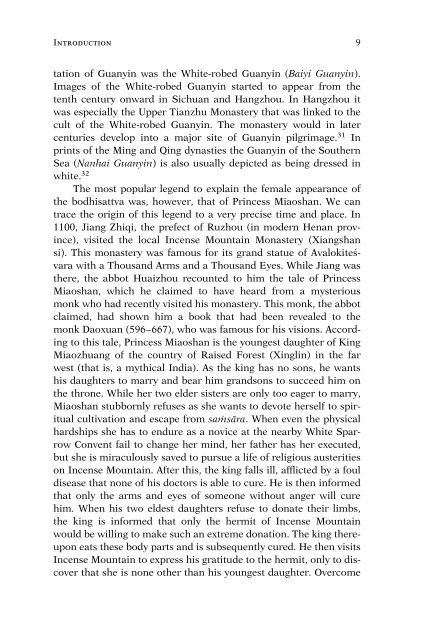Two Precious Scroll Narratives of Guanyin and Her ... - Khamkoo
Two Precious Scroll Narratives of Guanyin and Her ... - Khamkoo
Two Precious Scroll Narratives of Guanyin and Her ... - Khamkoo
Create successful ePaper yourself
Turn your PDF publications into a flip-book with our unique Google optimized e-Paper software.
Introduction 9<br />
tation <strong>of</strong> <strong>Guanyin</strong> was the White-robed <strong>Guanyin</strong> (Baiyi <strong>Guanyin</strong>).<br />
Images <strong>of</strong> the White-robed <strong>Guanyin</strong> started to appear from the<br />
tenth century onward in Sichuan <strong>and</strong> Hangzhou. In Hangzhou it<br />
was especially the Upper Tianzhu Monastery that was linked to the<br />
cult <strong>of</strong> the White-robed <strong>Guanyin</strong>. The monastery would in later<br />
centuries develop into a major site <strong>of</strong> <strong>Guanyin</strong> pilgrimage. 31 In<br />
prints <strong>of</strong> the Ming <strong>and</strong> Qing dynasties the <strong>Guanyin</strong> <strong>of</strong> the Southern<br />
Sea (Nanhai <strong>Guanyin</strong>) is also usually depicted as being dressed in<br />
white. 32<br />
The most popular legend to explain the female appearance <strong>of</strong><br />
the bodhisattva was, however, that <strong>of</strong> Princess Miaoshan. We can<br />
trace the origin <strong>of</strong> this legend to a very precise time <strong>and</strong> place. In<br />
1100, Jiang Zhiqi, the prefect <strong>of</strong> Ruzhou (in modern Henan province),<br />
visited the local Incense Mountain Monastery (Xiangshan<br />
si). This monastery was famous for its gr<strong>and</strong> statue <strong>of</strong> Avalokiteśvara<br />
with a Thous<strong>and</strong> Arms <strong>and</strong> a Thous<strong>and</strong> Eyes. While Jiang was<br />
there, the abbot Huaizhou recounted to him the tale <strong>of</strong> Princess<br />
Miaoshan, which he claimed to have heard from a mysterious<br />
monk who had recently visited his monastery. This monk, the abbot<br />
claimed, had shown him a book that had been revealed to the<br />
monk Daoxuan (596–667), who was famous for his visions. According<br />
to this tale, Princess Miaoshan is the youngest daughter <strong>of</strong> King<br />
Miaozhuang <strong>of</strong> the country <strong>of</strong> Raised Forest (Xinglin) in the far<br />
west (that is, a mythical India). As the king has no sons, he wants<br />
his daughters to marry <strong>and</strong> bear him gr<strong>and</strong>sons to succeed him on<br />
the throne. While her two elder sisters are only too eager to marry,<br />
Miaoshan stubbornly refuses as she wants to devote herself to spiritual<br />
cultivation <strong>and</strong> escape from saṁsāra. When even the physical<br />
hardships she has to endure as a novice at the nearby White Sparrow<br />
Convent fail to change her mind, her father has her executed,<br />
but she is miraculously saved to pursue a life <strong>of</strong> religious austerities<br />
on Incense Mountain. After this, the king falls ill, afflicted by a foul<br />
disease that none <strong>of</strong> his doctors is able to cure. He is then informed<br />
that only the arms <strong>and</strong> eyes <strong>of</strong> someone without anger will cure<br />
him. When his two eldest daughters refuse to donate their limbs,<br />
the king is informed that only the hermit <strong>of</strong> Incense Mountain<br />
would be willing to make such an extreme donation. The king thereupon<br />
eats these body parts <strong>and</strong> is subsequently cured. He then visits<br />
Incense Mountain to express his gratitude to the hermit, only to discover<br />
that she is none other than his youngest daughter. Overcome

















